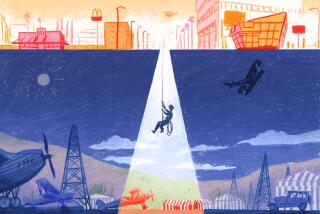His Career Was a Snap
It was a career of five decades spanning three generations of cameras.
Along the way, Lou Mack, who lives today in North Hollywood, photographed presidents, murderers, ingenues and, occasionally, real heroes.
Working well into his 70s for The Los Angeles Times, Mack became something of a heroic figure himself, driving to six or seven exhausting assignments a day to shoot everything from street fairs to Rotary lunches.
Exalted or mundane as the job may have been, Lou Mack always got his shot.
It was a different world when Mack first took up a Speed Graphic and followed police calls to the accident or crime scene that would net him a $5 freelance fee.
Today, photographers use rolls of film hoping to get that one great shot.
Back then, they had two photographic plates in a holder.
“The first one you shot immediately to get a picture,” Mack said. “The second one you held to see if you could get a better picture.”
Mack’s career began in 1939 when he got a mail clerk’s job at the Los Angeles Examiner. After serving in the Coast Guard during World War II, Mack returned as a copy boy in 1946 with aspirations to be a writer.
The bullying ways of legendary city editor Jim Richardson persuaded Mack to try the photo lab instead. Within a year he landed a full-time job in the era when the only rule of etiquette was to get the shot.
He once wrapped a Roloflex in a brown paper bag to sneak it into the nursery where the day-old baby of one of the singing Lennon sisters was being shielded from the press.
And he used a Leica from the wings of the Dorothy Chandler Pavilion to get a forbidden shot of virtuoso pianist Vladimir Horowitz at the keyboard.
Times City Editor Bill Boyarsky recalled one of Mack’s greatest scoops, a surreptitious shot of Dr. Bernard Finch and his lover, Carol Tregoff, during their celebrated trial for the murder of Finch’s wife.
Their lawyer had secured a private room where they shared lunch every day. Mack found it, aimed his bulky Speed Graphic through a crack in the door and caught the lovers eating out of a paper bag.
Boyarsky said Mack would have been barred from the courthouse by Judge Lance A. Ito during the O.J. Simpson trial, but he was lionized in the bars where the reporters and photographers hung out.
Mack knew a real hero when he saw one. Covering a brush fire, the reporter he was with jumped from their Jeep to help two motorcycle officers pull three young boys out of danger. Mack caught them on film with flames shooting over their shoulders.
The Pulitzer may have eluded him the night he waited outside Peter Lawford’s house for what his editor believed would be a tryst between President John F. Kennedy and Marilyn Monroe. She didn’t show.
He photographed Kennedy on Santa Monica Beach instead. He also got photos of Harry Truman at the Biltmore and Gov. Ronald Reagan at his home in Beverly Hills. As a freelancer, he followed Richard Nixon on the campaign trail for governorship of California.
“I didn’t care for the man,” he said.
Told by the staff that Nixon looked cold in the pictures, Mack replied, “Well, he is.”
Not so the beau of starlet Jayne Mansfield, who declined to sit for a picture because he was tired of being edited out.
“I’ll tell you what to do,” Mack said. “Pick up her toes, and just start kissing them.”
That was the shot.
More to Read
Sign up for Essential California
The most important California stories and recommendations in your inbox every morning.
You may occasionally receive promotional content from the Los Angeles Times.











